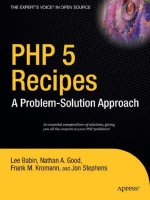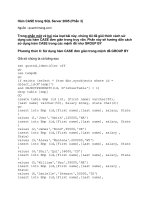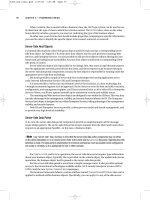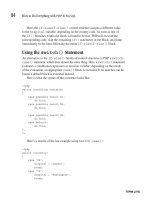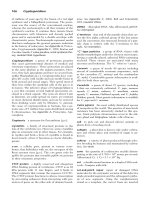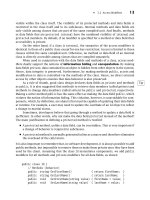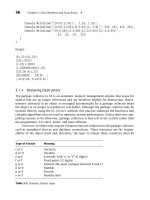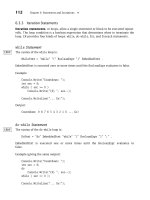PHP 5 Recipes A Problem-Solution Approach 2005 phần 3 pot
Bạn đang xem bản rút gọn của tài liệu. Xem và tải ngay bản đầy đủ của tài liệu tại đây (633.53 KB, 67 trang )
Beginning with PHP 5.0.2, you can cause the array returned by this function to preserve
the indexes of the original by passing an additional argument of TRUE:
$slice2 = array_slice($languages, 2, count($languages) - 2, TRUE);
printf("<pre>Slice 2:\n%s</pre>\n", var_export($slice2, TRUE));
?>
How It Works
You can see how this works by examining the output of the previous code and comparing
$slice1 and $slice2:
Original array:
array (
0 => 'French',
1 => 'German',
2 => 'Russian',
3 => 'Chinese',
4 => 'Hindi',
5 => 'Quechua',
6 => 'Spanish',
7 => 'Hausa',
)
Slice 1:
array (
0 => 'Russian',
1 => 'Chinese',
2 => 'Hindi',
3 => 'Quechua',
4 => 'Spanish',
5 => 'Hausa',
)
Slice 2:
array (
2 => 'Russian',
3 => 'Chinese',
4 => 'Hindi',
5 => 'Quechua',
6 => 'Spanish',
7 => 'Hausa',
)
4-21 ■ EXTRACTING A PORTION OF AN ARRAY 153
5092_Ch04_CMP4 8/26/05 3:02 PM Page 153
You can also use negative values for $offset and/or $length. If $offset is negative, then
the slice returned will start abs($offset) elements from the end of the array; if $length is neg-
ative, then the slice will end abs($length) elements from the end of the array. For instance,
given the following:
$slice3 = array_slice($languages, -6, -2, TRUE);
then $slice3 will be identical to $slice2 from the previous example.
Finally, you can obtain a slice consisting of all elements of an array beginning with the ele-
ment at index $offset all the way through to the end of the array simply by omitting the $length
argument. Assuming that $languages is the same array as defined in the last two examples, then
the following:
$last3 = array_slice($languages, -3);
printf("<p>Last 3: %s</p>\n", var_export($last3, TRUE));
will produce this output:
Last 3: array ( 0 => 'Quechua', 1 => 'Spanish', 2 => 'Hausa', )
Note that if you want to preserve the original keys, you must supply $length as well as
$preserve_keys, as using 0 (or any value that converts to 0, such as an empty string or NULL)
for $length will return an empty array. To get a slice consisting of the last three elements in
$languages while preserving the keys, you would need to use something like this:
$last3 = array_slice($languages, -3, 3, TRUE);
printf("<p>Last 3: %s</p>\n", var_export($last3, TRUE));
This will produce the expected result, as shown here:
Last 3: array ( 5 => 'Quechua', 6 => 'Spanish', 7 => 'Hausa', )
4-22. Extracting Values from Arrays with extract()
When working with an array, it is sometimes possible to save yourself some time and typing by
extracting its elements into simple variables. You do this using the extract() function. This func-
tion works by creating a set of variables whose names are taken from the associative array keys
and then setting the variables values to the array element values. We find this function particu-
larly handy when handling rows returned from database queries, such as those returned by
mysql_fetch_assoc() and mysqli_fetch_assoc(), but you can use this function anytime you
are obliged to work with arrays, especially those with many elements.
The Code
<?php
$customer = array('first' => 'Bill', 'last' => 'Jones', 'age' => 24,
'street' => '123 Main St.', 'city' => 'Pacifica',
'state' => 'California');
4-22 ■ EXTRACTING VALUES FROM ARRAYS WITH EXTRACT()154
5092_Ch04_CMP4 8/26/05 3:02 PM Page 154
extract($customer);
print "<p>$first $last is $age years old, and lives in $city, $state.</p>";
extract($customer, EXTR_PREFIX_ALL, 'cust');
print "<p>$cust_first $cust_last is $cust_age years old,
and lives in $cust_city, $cust_state.</p>";
?>
The print statements each output the following sentence:
Bill Jones is 24 years old, and lives in Pacifica, California.
Variations
extract() offers some additional options that can be helpful when the array keys might not be
legal variable identifiers or when you want to avoid overwriting existing variables that might
have the same name. (By default, extract() will overwrite such variables.) If you need to see
what variables are currently defined, you can call get_defined_vars() to obtain an array of all
their names.
EXTR_PREFIX_ALL adds a prefix string to the beginning of each key in the original array.
This option and the other extract() options that add a prefix to extracted variable names
automatically add an underscore character to the prefix. For example, the following will out-
put each of the values in the $scores array, in turn, on a separate line:
<?php
$scores = array(91, 56, 87, 79);
extract($scores, EXTR_PREFIX_ALL, "score");
print "<p>$score_0</p>";
print "<p>$score_1</p>";
print "<p>$score_2</p>";
print "<p>$score_3</p>";
?>
Another extremely handy option is EXTR_REFS, which extracts the variables as references
to the original associative array elements. The following code shows an example, which also
shows how you can combine options passed to extract() by ORing them together using the
pipe (|) operator. In this case, you will add the prefix pts to each array key and then make each
variable that results into a reference.
4-22 ■ EXTRACTING VALUES FROM ARRAYS WITH EXTRACT() 155
5092_Ch04_CMP4 8/26/05 3:02 PM Page 155
<?php
$points = array('home' => 21, 'away' => 13);
extract($points, EXTR_REFS|EXTR_PREFIX_ALL, 'pts');
$pts_home -= 4;
$pts_away += 6;
printf("<p>%s</p>", var_export($points, TRUE));
?>
Because the extracted variables are references, updating their values updates those of the
corresponding elements in the original array:
array ( 'home' => 17, 'away' => 19, )
You can pass several other options to extract() to exercise more fine-grained control over
when variables are or are not overwritten as well as when variable names are or are not prefixed;
however, we find that EXTR_PREFIX_ALL and EXTR_REFS satisfy most requirements, so we will let
you look up the others in the PHP manual if you are interested.
4-23. Extracting Values from an Array Using list()
The list() operator is technically not a function, even though it looks like one. It is also useful
for obtaining values, particularly when dealing with indexed arrays. The easiest way to explain
what list() does is to show you first and then explain afterward, so the following simple
example gets things started.
The Code
<?php
$scores = array(88, 75, 91, 84);
list($maths, $english, $history, $biology) = $scores;
printf("<p>Maths: %d; English: %d; History: %d; Biology: %d.</p>\n",
$maths, $english, $history, $biology);
?>
As you might expect, the output from this is as follows:
Maths: 88; English: 75; History: 91; Biology: 84.
4-23 ■ EXTRACTING VALUES FROM AN ARRAY USING LIST()156
5092_Ch04_CMP4 8/26/05 3:02 PM Page 156
How It Works
list() works by assigning values from the array on the right side of the equals sign to the vari-
ables passed to it, in order. So, in this example, $maths was set equal to $scores[0], $english to
$scores[1], and so on.
Variations
If some values in the array do not interest you, you can skip them by marking their places with
an “empty” comma, like so:
<?php
$scores = array(88, 75, 91, 84);
list($maths, , $history) = $scores;
# using the @ operator to suppress a warning about the undefined variables
@printf("<p>Maths: %d; English: %d; History: %d; Biology: %d.</p>\n",
$maths, $english, $history, $biology);
?>
Although only three array positions have been marked, this is completely permissible;
list() simply quits trying to make any assignments after it is finished with all the variables
you have supplied.
Since %d was used to mark the place of the undefined variable, its value is coerced to
integer 0, as shown here:
Maths: 88; English: 75; History: 0; Biology: 84.
If you try to use more variables with list() than there are elements in the array, you may
get a warning about an undefined index. You can suppress this warning with the @ operator
(also known as the error suppression operator). However, those variables will remain unset, as
shown here:
<?php
$scores = array(88, 75);
@list($maths, $english, $history) = $scores;
@printf("<p>Maths: %d; English: %d; History: %d; Biology: %d.</p>\n",
$maths, $english, $history, $biology);
?>
This is the output:
Maths: 88; English: 75; History: 0; Biology: 0.
Note that list() ignores elements with string keys.
4-23 ■ EXTRACTING VALUES FROM AN ARRAY USING LIST() 157
5092_Ch04_CMP4 8/26/05 3:02 PM Page 157
4-24. Combining Arrays
We have already discussed how to insert arrays into one another and have shown how to write
a function to help you do so. Now you will tackle something a bit different: combining two
indexed arrays to obtain an associative array. For example, suppose you have two arrays
defined as shown:
$colors = array('red', 'yellow', 'green');
$flavors = array('apple', 'banana', 'lime');
And suppose you would like to combine these into a single array that looks like this:
$fruit = array('red' => 'apple', 'yellow' => 'banana', 'green' => 'lime');
You might think that this requires writing some code that loops through both arrays,
assigning one string as a key and the other as its corresponding value, perhaps something
like this:
$fruit = array();
$limit = count($colors);
for($i = 0; $i < $limit; $i++)
$fruit[$colors[$i]] = $flavors[$i];
Of course, then you are obligated to perform some checks. Are the arrays the same length?
Are they both in fact arrays? Fortunately, PHP has a function that handles all these issues for you.
The Code
<?php
$colors = array('red', 'yellow', 'green');
$flavors = array('apple', 'banana', 'lime'); # same size as $colors
$tastes = array('sweet', 'sour'); # different size
$prices = array(); # empty
$name = 'lemon'; # not an array
$arrays = array('name' => $name, 'prices' => $prices,
'flavors' => $flavors, 'tastes' => $tastes);
foreach($arrays as $key => $value)
{
if($fruits = @array_combine($colors, $value))
printf("<pre>%s</pre>\n", var_export($fruits, TRUE));
else
printf("<p>Couldn't combine \$colors and \$%s.</p>", $key);
}
?>
4-24 ■ COMBINING ARRAYS158
5092_Ch04_CMP4 8/26/05 3:02 PM Page 158
You are using the @ operator in this example to suppress any warnings or errors triggered
by passing invalid parameters to array_combine() so that you can handle those using if
else. Here is the output from this code:
Couldn't combine $colors and $name.
Couldn't combine $colors and $prices.
array (
'red' => 'apple',
'yellow' => 'banana',
'green' => 'lime',
)
Couldn't combine $colors and $tastes.
How It Works
array_combine() takes two arrays as arguments, attempts to assign the values from the first
arrays as keys to the values found in the second, and returns an associative array if it succeeds.
If it fails for any reason (if both arguments are not arrays, if either or both of them are empty,
or if they do not contain the same number of values), the function returns FALSE.
4-25. Obtaining Array Keys and Values
What about the converse of the problem you looked at in the previous section? In other words,
what if you have an associative array named $fruits that is defined as shown here:
$fruits = array('red' => 'apple', 'yellow' => 'banana', 'green' => 'lime');
and you like to work with just the colors of the fruits, or just their names? PHP 5 provides a
pair of functions intended to make it easy to do this: array_keys() returns an array consisting
of only the keys of the array that it acts on, and array_values() returns an array consisting of
only the values of the original array. What follows is a simple example in which we have
defined an array_display() function to cut down on the repetition of code.
The Code
<?php
function array_display($array, $pre=FALSE) # set optional 2nd argument to
{ # TRUE for preformatted tree display
$tag = $pre ? 'pre' : 'p';
printf("<%s>%s</%s>\n", $tag, var_export($array, TRUE), $tag);
}
$fruits = array('red' => 'apple', 'yellow' => 'banana', 'green' => 'lime');
4-25 ■ OBTAINING ARRAY KEYS AND VALUES 159
5092_Ch04_CMP4 8/26/05 3:02 PM Page 159
$colors = array_keys($fruits);
$flavors = array_values($fruits);
array_display($fruits);
array_display($colors);
array_display($flavors);
?>
How It Works
This is pretty straightforward stuff. You start with the associative array $fruits as defined pre-
viously. You then use array_keys() to get the keys from $fruit and assign its return value to
the variable $colors. Next you use array_values() to get its values, assigning that function’s
return value to $flavors. Finally, you output all three variables using array_display(), which
is really nothing more than a wrapper for the var_export() function you looked at earlier in
the chapter (in recipe 4-8). The result is easy enough to predict, but we will show it to you any-
way for the sake of completeness:
array ( 'red' => 'apple', 'yellow' => 'banana', 'green' => 'lime', )
array ( 0 => 'red', 1 => 'yellow', 2 => 'green', )
array ( 0 => 'apple', 1 => 'banana', 2 => 'lime', )
■Tip If you use array_values() on an indexed array, you will just obtain an array whose structure is
identical to the first one, with one important exception: its indexes will be reordered. This can be a handy
way to “compact” sparse arrays.
4-26.Working with Unique Values
Often you will find yourself dealing with sets of data (arrays) containing duplicate values.
Although nothing is wrong with this in and of itself, many times you will be interested only in
unique values. For example, suppose you are involved with internationalizing a website, and
you are working with some logging data concerning countries from which your site has had
visitors and the languages spoken in those countries. Let’s assume you have already parsed
the log files and have ended up with an array defined as follows:
$countries = array( 'USA' => 'English', 'Spain' => 'Spanish',
'Brazil' => 'Portuguese', 'UK' => 'English',
'Mexico' => 'Spanish', 'Germany' => 'German',
'Colombia' => 'Spanish', 'Canada' => 'English',
'Russia' => 'Russian', 'Austria' => 'German',
'France' => 'French', 'Argentina' => 'Spanish');
4-26 ■ WORKING WITH UNIQUE VALUES160
5092_Ch04_CMP4 8/26/05 3:02 PM Page 160
To get the unique values in this array, all that is necessary is to use the built-in
array_unique() function, as shown next.
The Code
$languages = array_unique($countries);
printf("<pre>%s</pre>\n", var_export($languages, TRUE));
The output looks like this:
array (
'USA' => 'English',
'Spain' => 'Spanish',
'Brazil' => 'Portuguese',
'Germany' => 'German',
'Russia' => 'Russian',
'France' => 'French',
)
How It Works
The array_unique() function returns an array from which all duplicate values have been
removed. In cases of duplicate values, only the first element having that value is included
each time. (This can occasionally prove useful.) The key associated with each of these values
is preserved, as you can see in the previous output. This is true whether the array in question
is associative or indexed. If you want only the values, without the keys, you will need to use
the array_values() function (discussed in the previous section) on the result.
4-27. Getting and Displaying Counts of Array Values
Another frequent task is getting the number of elements that have unique values. The follow-
ing example shows one way you can do this, as applied to the $countries array defined in the
previous recipe.
The Code
<?php
$language_counts = array_count_values($countries);
?>
<table border="1" cellpadding="3" cellspacing="0">
<tbody>
<tr><th>Language</th><th>Number<br />of<br />Countries</th></tr>
<?php
foreach($language_counts as $language => $number)
print " <tr><td>$language</td><td>$number</td></tr>\n";
?>
</tbody>
</table>
4-27 ■ GETTING AND DISPLAYING COUNTS OF ARRAY VALUES 161
5092_Ch04_CMP4 8/26/05 3:02 PM Page 161
How It Works
This works by using the function array_count_values(), which creates a new array whose keys
are the values of the array passed to it as a parameter and whose values are the number of
times each of those values occurs in the original array.
We have dressed up the output just a bit this time by using a HTML table. To obtain this,
just loop through the $language_count array, writing a new two-column row for each element
and inserting the key into one table cell and the value into another cell. Figure 4-1 shows the
result as viewed in a typical web browser.
Figure 4-1. Output of the countries and languages example (counts of unique values)
Notice that the keys of this array are the unique values from the original array. In other words,
array_keys($language_count) is identical to array_values(array_unique($countries)).
Finding and Working with Array Values
If you know the key for a given array element, whether the key is a string or an integer, finding
the matching value is trivial. Doing the opposite is not that difficult, but it does require a bit
more effort. In this section, we will show you how to answer questions such as these:
• Does an element with a given value exist in an array?
• Does an array contain an element with a given key?
•At what position can you find an element with a desired value in an array? That is, what
key or keys correspond to the value being sought?
4-27 ■ GETTING AND DISPLAYING COUNTS OF ARRAY VALUES162
5092_Ch04_CMP4 8/26/05 3:02 PM Page 162
• How can you find the elements in an array whose values meet a set of criteria or pass a
certain test?
• What is the best way to find the maximum or minimum value in an array?
• How do you apply a function to all the elements in an array?
PHP has functions that can help you with all these issues. In addition, we will show you
a programming algorithm or two that might be beneficial in solving some of these problems
and maybe slip in one or two other bits of useful array-related functionality.
4-28. Determining Whether an Element Is in an Array
Often you will need to find out whether a set of values contains one value in particular. Recall
the internationalization example (see recipe 4-26); you have data reflecting the countries from
which website visitors originated, and the languages spoken in those countries, represented
by the following array:
$countries = array( 'USA' => 'English', 'Spain' => 'Spanish',
'Brazil' => 'Portuguese', 'UK' => 'English',
'Mexico' => 'Spanish', 'Germany' => 'German',
'Colombia' => 'Spanish', 'Canada' => 'English',
'Russia' => 'Russian', 'Austria' => 'German',
'France' => 'French', 'Argentina' => 'Spanish');
A natural question might be, do any of the site’s visitors speak Spanish? To obtain an
answer, you might be tempted to use brute force by traversing the $countries array and test-
ing each element’s value in turn until you either find a match for the desired value or exhaust
all of the array’s elements. Fortunately, PHP has a function that does this for you.
The following example tests in_array() by using the $countries array defined previously
as a “haystack” in which to search for a couple of likely values.
The Code
<?php
# $countries array previously defined in text
$language = 'Spanish';
printf("<p>%s of our visitors speak %s.</p>\n",
in_array($language, $countries) ? 'Some' : 'None',
$language);
$language = 'Swahili';
printf("<p>%s of our visitors speak %s.</p>\n",
in_array($language, $countries) ? 'Some' : 'None',
$language);
?>
4-28 ■ DETERMINING WHETHER AN ELEMENT IS IN AN ARRAY 163
5092_Ch04_CMP4 8/26/05 3:02 PM Page 163
The output from this bit of code is as follows:
Some of our visitors speak Spanish.
None of our visitors speak Swahili.
How It Works
in_array() takes two arguments, a value to be matched and the array to be searched for the
value. It returns TRUE if the value is found and FALSE if it is not. Here is the function’s prototype:
bool in_array(mixed $value, array $array[, bool $strict])
The matching of strings is case-sensitive; in other words, spanish is not considered a
match for Spanish. The optional $strict parameter, if TRUE, forces this function to use strict
equality (as with ===) in making any comparisons rather than allowing type conversions to
occur (as if the function were using ==). In other words, if you use strict mode, then the num-
ber 12 will not match the string "12".
This function works just as well with indexed arrays as it does with associative arrays; we
used an associative array in the previous example to emphasize that in_array() matches val-
ues and not keys. We will show how to do that in the next recipe.
4-29. Testing for the Existence of a Key in an Array
Sometimes you need to answer a question such as, is there an item number 5 in this set? Or
you might ask, does the information for this customer include a postcode? If the datasets in
question are arrays, then PHP makes it simple to find the answer. To determine whether an
array contains an element with a given key or index, all you need to do is use the
array_key_exists() function.
Once again, using the $countries array defined in the previous section (and assuming
that this array includes language data for all countries from which the site has had hits), this
example asks and answers the question, has our site had any visitors from Country X?
The Code
<?php
# $countries array from previous recipe
$country = 'Kazakhstan';
printf("<p>%s of our visitors are from %s.</p>\n",
array_key_exists($country, $countries) ? 'Some' : 'None',
$country);
$country = 'Argentina';
printf("<p>%s of our visitors are from %s.</p>\n",
array_key_exists($country, $countries) ? 'Some' : 'None',
$country);
?>
4-29 ■ TESTING FOR THE EXISTENCE OF A KEY IN AN ARRAY164
5092_Ch04_CMP4 8/26/05 3:02 PM Page 164
None of our visitors are from Kazakhstan.
Some of our visitors are from Argentina.
How It Works
The prototype for array_key_exists() is as follows:
bool array_key_exists(mixed $key, array $array)
If an element with a key matching $key is found in $array, the function returns TRUE;
otherwise, it returns FALSE. The comparisons made by this function are case-sensitive but not
strict. In other words, a search for a "usa" key will not match a "USA" key, but a search for a "2"
key (string value) will return TRUE if the array contains an element with the index 2 (integer).
4-30. Obtaining Array Keys with a Given Value
Another common task involves obtaining one or more keys of array elements with a known
value. In other words (harking back once again to the $countries array you have been using in
the past few sections), you want to know the answer to the question, in which of the countries
where you have users is Spanish spoken? No built-in function gives you this sort of informa-
tion, but you can write one of your own easily enough.
The Code
<?php
# Note: $countries array as previously defined
# prototype: mixed array_get_keys(mixed $search, array $array)
function array_get_keys($search, $array)
{
$keys = array(); # array to contain keys for output
foreach($array as $key => $value) # traversing the array
if($value == $search) # if the current value matches $search
$keys[] = $key; # append the current key to the output array
if(count($keys) == 0) # if no keys were appended to $keys
$keys = FALSE; # set its value to boolean FALSE
return $keys;
}
$language = 'Spanish';
$spoken = array_get_keys($language, $countries);
4-30 ■ OBTAINING ARRAY KEYS WITH A GIVEN VALUE 165
5092_Ch04_CMP4 8/26/05 3:02 PM Page 165
printf("<p>Countries where %s is spoken: %s.</p>\n",
$language,
$spoken ? implode(', ', $spoken) : 'None');
$language = 'Tagalog';
$spoken = array_get_keys($language, $countries);
printf("<p>Countries where %s is spoken: %s.</p>\n",
$language,
$spoken ? implode(', ', $spoken) : 'None');
?>
How It Works
You have defined array_get_keys() in such a way that it returns FALSE if no matching keys are
found on the premise that most code calling this function would need to test this in any case.
Of course, if you prefer, you could always rewrite the printf() statement (and get rid of the
intermediate variable $spoken) using something like this:
printf("<p>Countries where %s is spoken: %s</p>",
$language,
array_key_exists($language)
? implode(', ', array_get_keys($language, $country))
: 'None');
In any case, the output from the example code is as follows:
Countries where Spanish is spoken: Spain, Mexico, Colombia, Argentina.
Countries where Tagalog is spoken: None.
4-31. Finding the Greatest and Least Values in an Array
One common task in computing is to find the minimum and maximum among a set of
values. In PHP, the min() and max() functions work not only on sets of values (for example,
$max = max(2, 8, 6, -3, 17)) but also on arrays.
The Code
<?php
$prices = array(12.95, 24.5, 10.5, 5.95, 7.95);
printf("<p>Highest price: \$%.2f; lowest price: \$%.2f.</p>\n",
max($prices), min($prices));
?>
4-31 ■ FINDING THE GREATEST AND LEAST VALUES IN AN ARRAY166
5092_Ch04_CMP4 8/26/05 3:02 PM Page 166
Here is the output:
Highest price: $24.50; lowest price: $5.95.
Variations
These functions also work with associative arrays:
<?php
$clothes = array( 'hats' => 75, 'coats' => 32, 'shoes' => 102,
'gloves' => 15, 'shirts' => 51, 'trousers' => 44);
uasort($clothes, 'evenfirst');
var_export($clothes);
printf("<p>Most items: %d; least items: %d.</p>\n",
max($clothes), min($clothes));
?>
This is the output:
Most items: 102; least items: 15.
Because they do not provide access to array keys, these functions are mostly useful with
one-dimensional, indexed arrays. In many cases, you are better off using one of the sorting
techniques later in this chapter. For example:
<?php
$clothes = array( 'hats' => 75, 'coats' => 32, 'shoes' => 102,
'gloves' => 15, 'shirts' => 51, 'trousers' => 44);
$names = array_keys($clothes);
$items = array_values($clothes);
array_multisort($items, $names);
$num = count($clothes) - 1;
printf("<p>Most items: %s (%d); least items: %s (%d).</p>\n",
$names[$num], $items[$num], $names[0], $items[0]);
?>
This is the output:
Most items: shoes (102); least items: gloves (15).
4-31 ■ FINDING THE GREATEST AND LEAST VALUES IN AN ARRAY 167
5092_Ch04_CMP4 8/26/05 3:02 PM Page 167
Another problem with trying to get by on min() and max() is that they assume all values
passed to them are numeric, which means strings are coerced to zero. For more about sorting
arrays, see the “Sorting Arrays” section of this chapter.
4-32. Finding the Sum and Average of the Values in an Array
Obtaining the sum of a set of numbers in PHP is trivially easy, thanks to the array_sum() func-
tion, which adds all of the array’s values and returns the total. For example, this code returns
the value 12:
array_sum( array(2, 2, 8) )
This function attempts to convert any non-numeric values to numbers. This may or may
not be desirable behavior, depending upon your circumstances, so keep this in mind when-
ever you use this function.
■Note In older versions of PHP (through PHP 4.2.1), a bug in array_sum() caused this function to perform
a type conversion of numbers of all the elements in the array it was used on, with the result that string values
could be converted to zero. In PHP 5 this is not an issue, and you may safely use
array_sum() on an array
without having to worry about creating a copy for fear of modifying the original.
Calculating the average value is also fairly simple, since all you need are the sum of the
array values and how many of them there are. Then you just perform a straightforward divi-
sion. The following array_average() function does this. It also checks for the argument type
and makes sure the array has at least one element so you do not get tripped up by a possible
division-by-zero error.
The Code
<?php
# obtain the average value of an array's elements
# prototype (returns a number or FALSE if an average cannot be calculated):
# mixed array_average(array $array)
function array_average($array)
{
$retval = FALSE;
if(is_array($array) && count($array)) # if the argument is an array
# with at least one element
$retval = array_sum($array) / count($array); # divide the sum of the element
# values by the number of values
return $retval;
}
4-32 ■ FINDING THE SUM AND AVERAGE OF THE VALUES IN AN ARRAY168
5092_Ch04_CMP4 8/26/05 3:02 PM Page 168
# test the function
$scores = array('Bill' => 87.5, 'Jan' => 94.8, 'Terry' => 80.0,
'Andy' => 91.5, 'Lisa' => 95.5);
printf("<p>There are %d scores, totaling %.2f and averaging %.2f.</p>",
count($scores), array_sum($scores), array_average($scores));
?>
The result of this test is as follows:
There are 5 scores, totaling 449.30 and averaging 89.86.
Applying Functions to Arrays
If you need to make a uniform alteration in all the elements of an array (that is, apply a func-
tion to each element in the array), you could traverse the array using a for, foreach, or while
loop. Similarly, if you need to select elements from an array that meet a given condition, you
could traverse the array, applying a test to each element in turn and then copying that element
into a new array if it meets the test or (if you want to alter the original array) unsetting the ele-
ment if it fails to meet a converse test. PHP provides alternatives for both of these tasks, which
you will investigate in the following two recipes.
PHP 5 has two ways you can apply a function to each of the elements in an array; such
a function is a callback function (or simply a callback). Your choice depends on whether you
want to act upon the array’s elements already in place or create a new array consisting of the
elements from the original after they have been modified. In the former case, you will want
to use the array_walk() function (see recipe 4-34); in the latter, the proper function to use is
array_map() (see recipe 4-35).
Both array_walk() and array_map() can be powerful and useful, so we encourage you to
spend some time experimenting with them—you will be amazed at what you can accomplish
with them. Here is a quick summary of the differences between them:
array_walk() works on a single array in place; you can think of it as walking through an
array, changing it as it goes. It returns a value of only TRUE or FALSE to indicate success or
failure. It modifies element values and can access array keys as well as a value supplied by
the programmer, although it cannot modify the keys themselves. The callback function
used with array_walk() does not need to return a value and must include a reference to
the value of an array element in its signature. If the callback includes a user-supplied
value in its signature, the signature must also include a parameter corresponding to an
element’s key, even if the key is not used within the callback function.
array_map() works on one or more arrays; think of it as mapping from one array (or set of
arrays) to another array. It does not modify the original array(s) and can access only the
values of the array(s), not the keys. In addition, you can’t pass a user value to it. The call-
back function used with array_map() must return a value, and array_map() itself returns
an array. If more than one array is used, the arrays do not need to be the same size; if they
are not, array_map() will pad any “missing” values with nulls.
4-32 ■ FINDING THE SUM AND AVERAGE OF THE VALUES IN AN ARRAY 169
5092_Ch04_CMP4 8/26/05 3:02 PM Page 169
Another way in which functions can be applied to arrays is by filtering them. When we
speak of filtering arrays, we mean the process of inspecting each element in an array to see
whether it meets a certain test or set of conditions and retaining the element for subsequent
use or tossing it into the trash bin, so to speak, as result of that test. In the array_filter()
function, which is used for filtering arrays, you have another example of a PHP language con-
struct that can save you a great deal of time and energy that would otherwise be spent writing
and debugging loops.
In the recipes that follow, we will demonstrate how to use array_walk(), array_map(), and
array_filter().
4-33. Applying Functions to Array Elements Using array_walk()
The following example shows the simplest case for using array_walk() to apply a function to
each element of an array; you will apply a function named modify() to each element of an
array named $array. The outcome you are trying to achieve in this case is to multiply each
number in $array by a constant without writing a loop. Let’s look at the code first, and then
we will provide some explanation and elaborate on this theme.
The Code
<?php
function array_display($array, $pre=FALSE)
{
$tag = $pre ? 'pre' : 'p';
printf("<%s>%s</%s>\n", $tag, var_export($array, TRUE), $tag);
}
In this case, you are not using the array key for anything, and you are not passing in any
values to the callback, so its signature requires only a single parameter (a reference to the cur-
rent array element’s value).
function modify(&$value)
{
$value *= 1.5;
}
$array = array(10, -3.5, 2, 7); # array containing some numbers
array_display($array, TRUE); # display it as defined
array_walk($array, 'modify'); # apply modify() to all the elements in $array
array_display($array, TRUE); # display the modified array
?>
4-33 ■ APPLYING FUNCTIONS TO ARRAY ELEMENTS USING ARRAY_WALK()170
5092_Ch04_CMP4 8/26/05 3:02 PM Page 170
Here is the output of this script, showing that the values stored in $array have indeed
been updated by the callback function:
array (
0 => 10,
1 => -3.5,
2 => 2,
3 => 7,
)
array (
0 => 15,
1 => -5.25,
2 => 3,
3 => 10.5,
)
How It Works
The prototype for array_walk() is as follows:
bool array_walk(array &$array, string $funcname[, mixed $data])
This function returns TRUE if successful and FALSE in the event of failure. When called,
the function named funcname acts on the elements of an array. The prototype for the callback
function is generally of the following form:
void funcname(mixed &$value[, $mixed $key[, mixed $data]])
The callback does not return a value; instead, it acts on each array value in place (indicated
by the & operator), which it expects to receive as the first argument. The second argument is the
element’s key. An optional third argument representing data to be used in the function may also
be present. Note that if the callback uses a data parameter, then a key parameter must be pres-
ent in the callback’s signature whether or not it is actually used in the callback function.
■Tip If for some reason you need to pass more than one user value to the callback function, you will need
to pass it via some structure such as an array, as there can be only one data variable.
4-33 ■ APPLYING FUNCTIONS TO ARRAY ELEMENTS USING ARRAY_WALK() 171
5092_Ch04_CMP4 8/26/05 3:02 PM Page 171
Variations
Here is a slightly more complex example that uses both the array key and a passed-in value to
modify each element value:
<?php
function change(&$element, $key, $mark)
{
$element = "$mark$key$mark, the $element";
}
$dogs = array('Lassie' => 'Collie', 'Bud' => 'Sheepdog',
'Rin-Tin-Tin' => 'Alsatian', 'Snoopy' => 'Beagle');
array_display($dogs, TRUE);
array_walk($dogs, 'change', '*');
array_display($dogs, TRUE);
?>
The output, which displays the $dogs array before and after modification, is as follows:
array (
'Lassie' => 'Collie',
'Bud' => 'Sheepdog',
'Rin-Tin-Tin' => 'Alsatian',
'Snoopy' => 'Beagle',
)
array (
'Lassie' => '*Lassie*, the Collie',
'Bud' => '*Bud*, the Sheepdog',
'Rin-Tin-Tin' => '*Rin-Tin-Tin*, the Alsatian',
'Snoopy' => '*Snoopy*, the Beagle',
)
Of course, the actual names you assign to the callback function’s parameters are not
important as long as you know which one is which and use them appropriately.
■Caution A callback function used by array_walk() may not modify the array, only the values of the
array’s elements. In other words, the callback may not insert or delete elements, and it may not modify
any keys.
4-33 ■ APPLYING FUNCTIONS TO ARRAY ELEMENTS USING ARRAY_WALK()172
5092_Ch04_CMP4 8/26/05 3:02 PM Page 172
4-34. Applying Functions to Array Elements Using array_map()
Now let’s look at applying a function to array elements using array_map(). This time we will
also apply a slightly more complex callback function to create a negative-safe square root
function, which tests the input value to see whether it is a negative number and takes appro-
priate action if it does.
The Code
<?php
function array_display($array, $pre=FALSE)
{
$tag = $pre ? 'pre' : 'p';
printf("<%s>%s</%s>\n", $tag, var_export($array, TRUE), $tag);
}
function safe_sqrt($num)
{
return sqrt( abs($num) ) . ($num < 0 ? 'i' : '');
}
$values = array(3, 8, -3, 0, 14, -4);
$roots = array_map('safe_sqrt', $values);
print '<p>Values:</p>';
array_display($values, TRUE);
print '<p>Square roots:</p>';
array_display($roots, TRUE);
?>
Here is the output generated by this example:
Values:
array (
0 => 3,
1 => 8,
2 => -3,
3 => 0,
4 => 14,
5 => -4,
)
4-34 ■ APPLYING FUNCTIONS TO ARRAY ELEMENTS USING ARRAY_MAP() 173
5092_Ch04_CMP4 8/26/05 3:02 PM Page 173
Square roots:
array (
0 => '1.7320508075689',
1 => '2.8284271247462',
2 => '1.7320508075689i',
3 => '0',
4 => '3.7416573867739',
5 => '2i',
)
How It Works
The callback function safe_sqrt() is applied to each number from the $values array in turn. As
you might recall from mathematics classes, the square root of a negative number can be repre-
sented using i or j (a so-called imaginary number equal to the square root of -1). Using this
notation, you can represent the square root of -4 as 2i, so that 2i * 2i = (2 * 2) * (i * i) = 4 * -1 = -4.
As already mentioned, the array_map() function returns a new array whose elements are
the modified values of the array it acts upon. Its prototype is as follows:
array array_map(string $funcname, array $arr1[, array $arr2 ])
The arguments to this function are the name of the callback function followed by one or
more array variables. This callback function works somewhat differently than the one that is
used by array_walk(). Its prototype is as follows:
mixed funcname(array $arr1[, array $arr2[, array $arr3[, ]]])
In other words, the callback takes one or more array variables as parameters, and these
parameters must be the same number of array variables as passed to array_map(). When you
pass an array variable to array_map(), the callback function actually “sees” a single element of
this array at a time.
Also, do not forget that the first argument to array_map() is a string and must be quoted.
This means that since the name of the callback function in the example is safe_sqrt, you need
to refer to it as "safe_sqrt" (including the quotation marks) when calling it from array_map().
■Tip You are not limited to user-defined functions with array_map(); you can also employ native PHP
functions. For example, if you need to check the sort order for some special characters, you can generate a
string containing all the printable characters available in the Extended ASCII character set, in order, with this
bit of code that uses the chr() function: $chars = implode('', array_map('chr', range(32, 255)));.
You can also use the array_map() function without any callback function to generate
nested arrays. See recipe 4-24 for an example.
4-34 ■ APPLYING FUNCTIONS TO ARRAY ELEMENTS USING ARRAY_MAP()174
5092_Ch04_CMP4 8/26/05 3:02 PM Page 174
4-35. Filtering Arrays Using array_filter()
In the previous two sections, you had a chance to see how you can use a function to modify all
the elements of an array. Now you will look at a slightly different way to apply a function to an
array’s elements: you will subject each element to a test and derive a new array containing
only those elements that have passed the test.
If you recall the website internationalization scenario from a few sections back, you will
remember that you were working with a list of countries and the languages spoken in those
countries, defined like so:
$countries = array( 'USA' => 'English', 'Spain' => 'Spanish',
'Brazil' => 'Portuguese', 'UK' => 'English',
'Mexico' => 'Spanish', 'Germany' => 'German',
'Colombia' => 'Spanish', 'Canada' => 'English',
'Russia' => 'Russian', 'Austria' => 'German',
'France' => 'French', 'Argentina' => 'Spanish');
Let’s say you want a list of only those countries in which romance languages are spoken.
You can also represent these as an array: ('French', 'Spanish', 'Portuguese', 'Italian').
What you want to do is check each country (element in $countries) in turn and see whether
its value is one of the values in this array of romance language names. You might recall that
to determine whether a given value is found in an array, you can use the in_array() function
somehow. Rather than write a loop that uses that function, there is a better way to use in_array().
The Code
function is_rom($lang)
{
return in_array($lang, array('French', 'Spanish', 'Portuguese', 'Italian')));
}
Now let’s put this altogether:
<?php
function array_display($array, $pre=FALSE)
{
$tag = $pre ? 'pre' : 'p';
printf("<%s>%s</%s>\n", $tag, var_export($array, TRUE), $tag);
}
function is_romance($lang)
{
return in_array($lang, array('French', 'Spanish', 'Portuguese', 'Italian'));
}
$countries = array( 'USA' => 'English', 'Spain' => 'Spanish',
'Brazil' => 'Portuguese', 'UK' => 'English',
'Mexico' => 'Spanish', 'Germany' => 'German',
'Colombia' => 'Spanish', 'Canada' => 'English',
4-35 ■ FILTERING ARRAYS USING ARRAY_FILTER() 175
5092_Ch04_CMP4 8/26/05 3:02 PM Page 175
'Russia' => 'Russian', 'Austria' => 'German',
'France' => 'French', 'Argentina' => 'Spanish');
$rom_countries = array_filter($countries, 'is_romance');
array_display($rom_countries, TRUE);
?>
Here is the output:
array (
'Spain' => 'Spanish',
'Brazil' => 'Portuguese',
'Mexico' => 'Spanish',
'Colombia' => 'Spanish',
'France' => 'French',
'Argentina' => 'Spanish',
)
How It Works
The function prototype for array_filter looks like this:
array array_filter(array $array, string $funcname)
This function filters an array represented by the variable $array using a callback function
whose name is funcname. The callback acts on an element of this array and returns a boolean
value. In this case, when array_filter() is invoked, it calls is_rom() for each value in
$countries one after another. If is_rom() returns TRUE, then that element is appended to the
output of array_filter(). As you can see by examining the output of this example, the origi-
nal array keys are preserved.
The callback function can be virtually anything you like, as long as it takes a single input
parameter (corresponding to an array element’s value) and returns a boolean. The only other
restriction is that the original array may not be altered by the callback function.
Variations
A quick way to rid an array of “empty” array elements is to call array_filter() with no call-
back function. This has the effect of providing a copy of the original array except for those
elements whose values evaluate to FALSE, as shown here:
<?php
# array_display() function as was defined previously
$arr = array(2, 'two', 0, 'NULL', NULL, 'FALSE', FALSE, 'empty', '');
$copy = array_filter($arr);
$reindexed = array_values($copy);
4-35 ■ FILTERING ARRAYS USING ARRAY_FILTER()176
5092_Ch04_CMP4 8/26/05 3:02 PM Page 176
print '<p>Original:</p>';
array_display($arr, TRUE);
print '<p>Filtered:</p>';
array_display($copy, TRUE);
print '<p>Filtered and reindexed:</p>';
array_display($reindexed, TRUE);
?>
Notice that when you want to use array_filter() in this way, you simply omit the call-
back parameter. Once again, you can see that the original keys are preserved. If you want the
elements to be reindexed, you can always use array_values(), as discussed earlier in this
chapter (see recipe 4-25).
Original:
array (
0 => 2,
1 => 'two',
2 => 0,
3 => 'NULL',
4 => NULL,
5 => 'FALSE',
6 => false,
7 => 'empty',
8 => '',
)
Filtered:
array (
0 => 2,
1 => 'two',
3 => 'NULL',
5 => 'FALSE',
7 => 'empty',
)
Filtered and reindexed:
array (
0 => 2,
1 => 'two',
2 => 'NULL',
3 => 'FALSE',
4 => 'empty',
)
4-35 ■ FILTERING ARRAYS USING ARRAY_FILTER() 177
5092_Ch04_CMP4 8/26/05 3:02 PM Page 177
